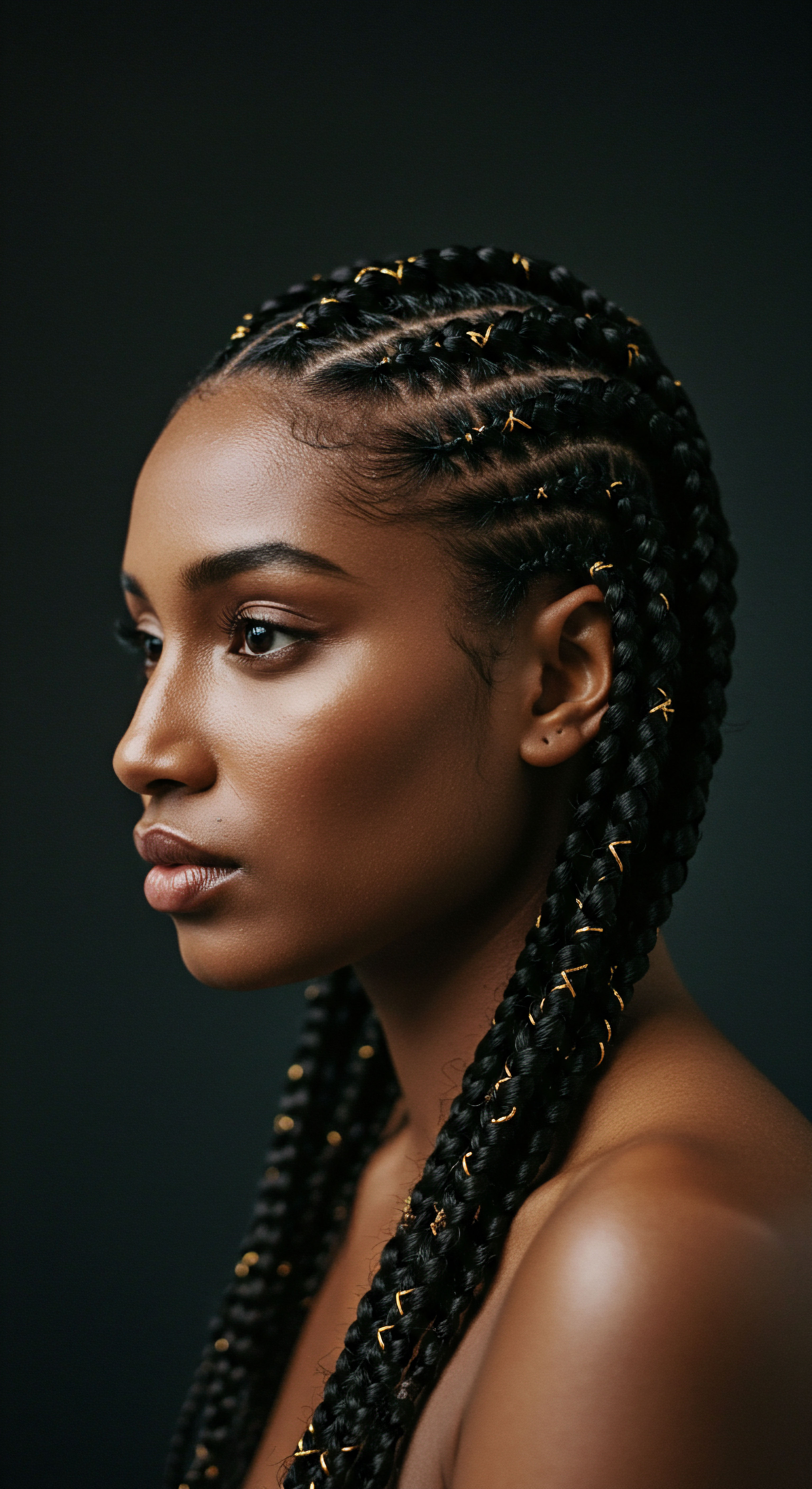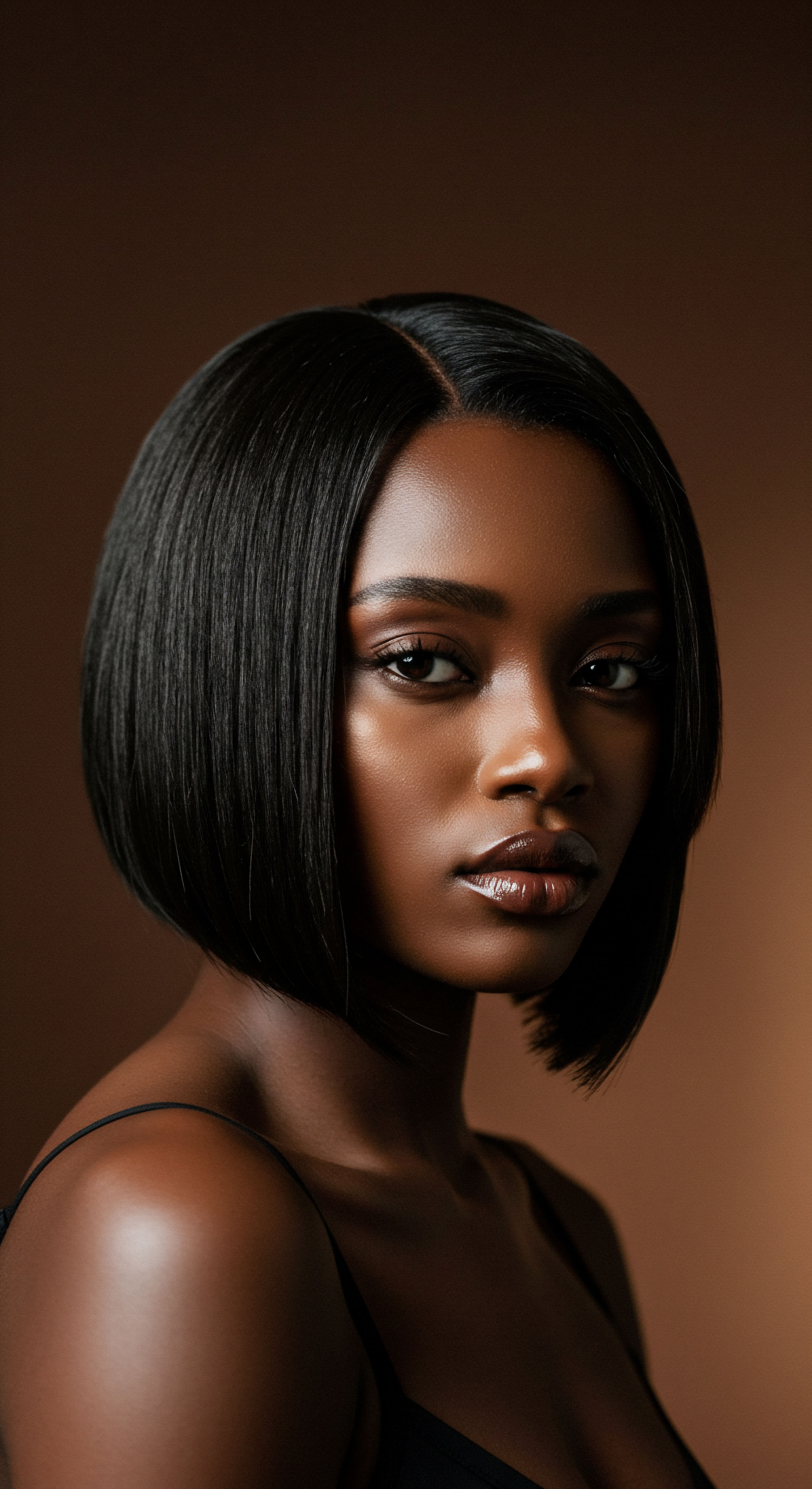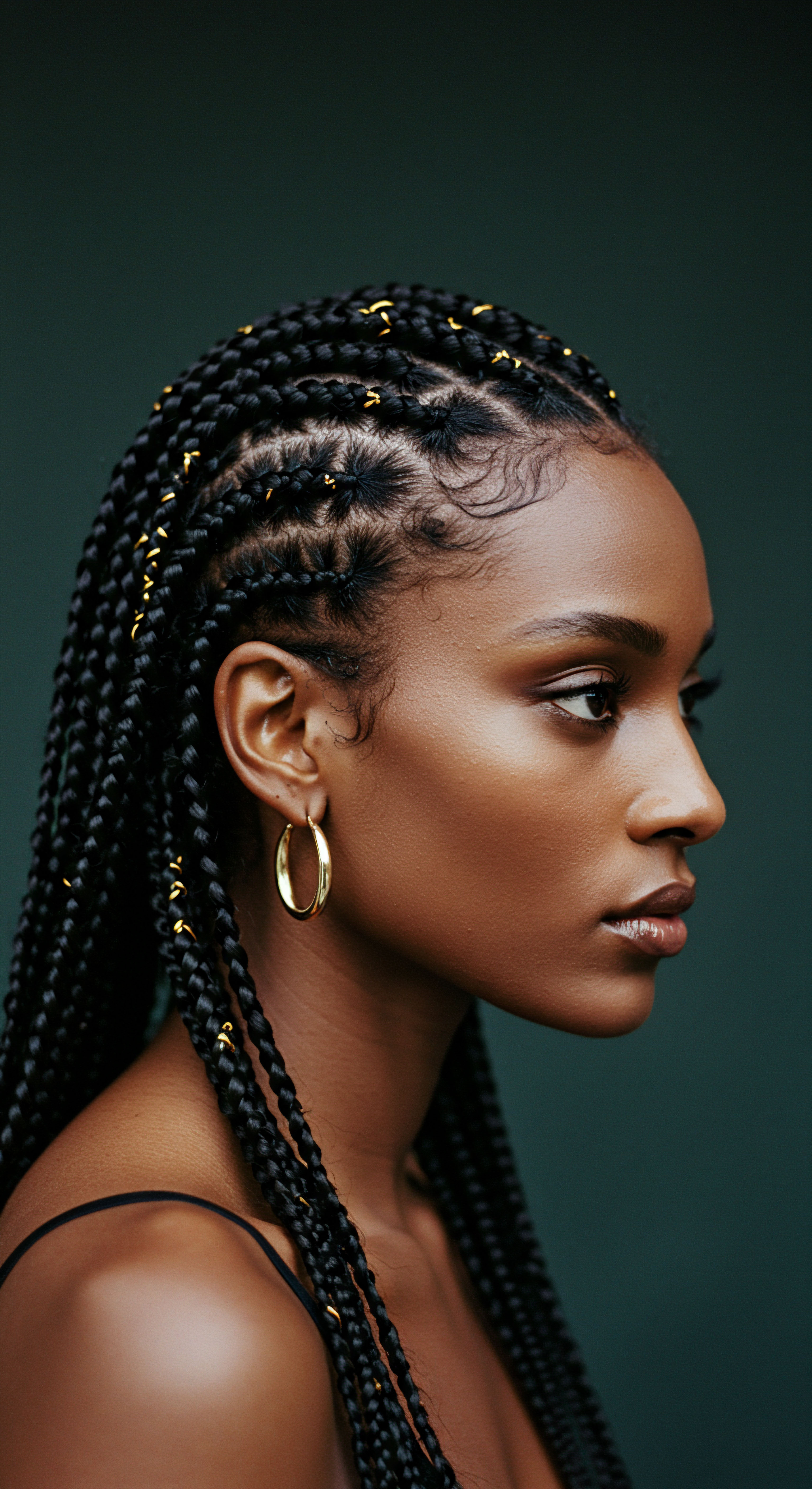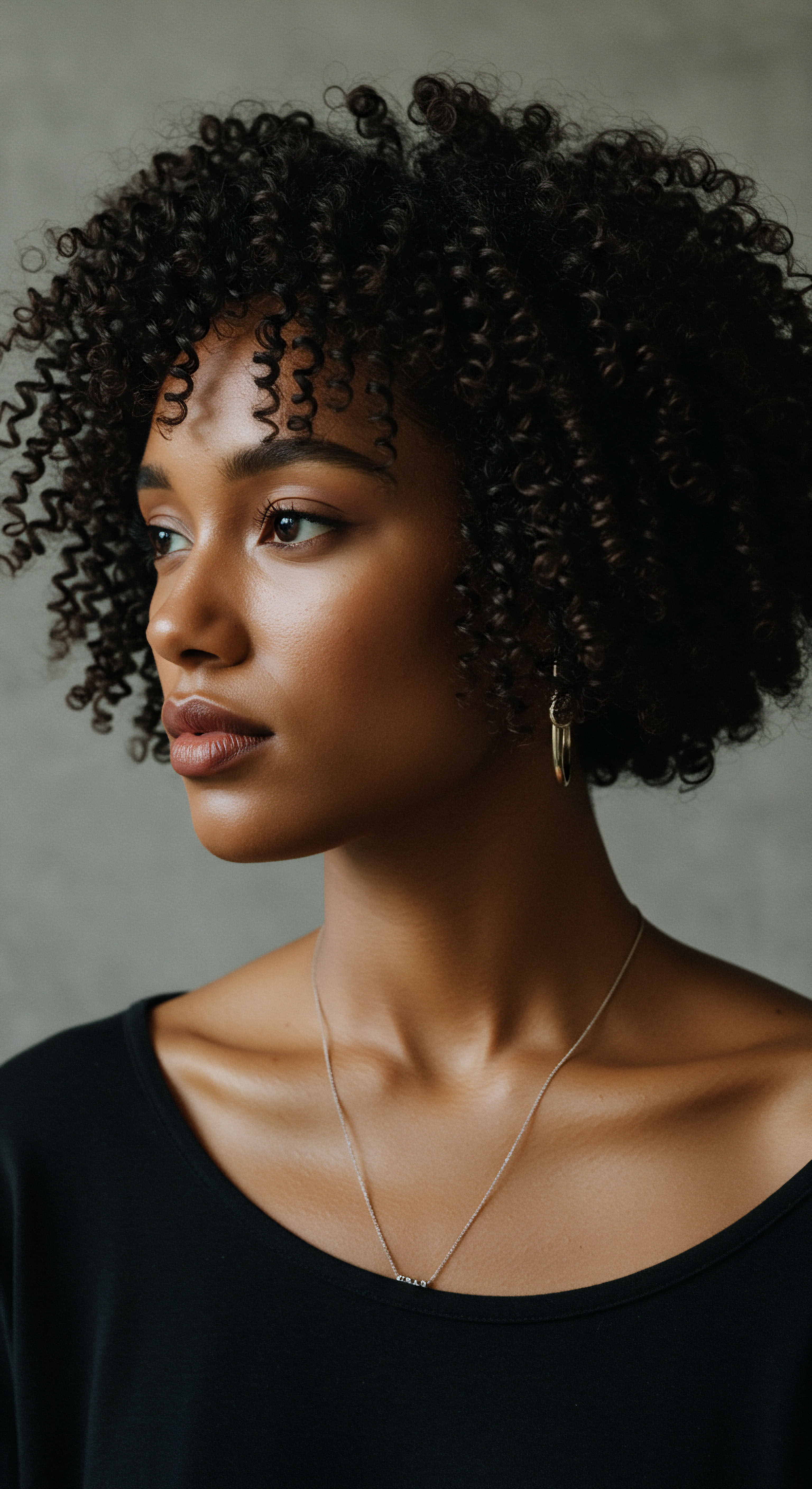
Roots
To consider the gentle curves of the hairline, the delicate wisps that frame our faces, is to look upon a tender landscape. For those with textured hair, these ‘edges’ are not merely hair; they represent a soft boundary, a tender point of connection between the inner self and the outer world. They are often the first place we notice shifts, subtle changes that can whisper stories of imbalance long before they shout. Understanding why these particular strands might begin to recede or diminish requires a patient, grounded exploration, beginning with the very essence of hair itself and its intricate life cycle.
Every strand of hair, from the robust crown to the fine edges, begins its journey deep within the scalp, cradled by a tiny organ known as the Hair Follicle. These follicles are remarkable biological structures, each operating with its own rhythm, a dance of growth, rest, and renewal. For textured hair, the follicle’s shape plays a significant role in the hair’s characteristic curl pattern.
An oval or flattened follicle produces the beautiful spirals and coils we admire, while a rounder follicle creates straighter strands. This inherent curvature means textured hair naturally possesses more points of vulnerability along its shaft, making it more prone to breakage, particularly at the delicate edges where strands are often finer and less densely populated.

The Hair’s Cyclical Existence
Hair does not simply grow and stay; it follows a predictable, cyclical pattern, a testament to the body’s constant state of renewal. This cycle comprises four distinct phases, each holding significance for the overall health and presence of our hair.
Hair’s cyclical journey, from active growth to gentle release, forms the basis of its enduring presence.
- Anagen Phase ❉ This is the active growth period, where cells within the follicle rapidly divide, forming new hair. This phase can stretch for years, dictating the ultimate length a hair strand can attain. Approximately 85% of hair is in this active state at any given moment.
- Catagen Phase ❉ A brief transitional period, lasting only a few weeks, where hair growth halts. The follicle shrinks, and the hair detaches from its blood supply.
- Telogen Phase ❉ A resting phase, typically lasting a few months, during which the hair remains in the follicle but is not actively growing. About 10-15% of hair is in this stage.
- Exogen Phase ❉ The shedding phase, an extension of telogen, where the old hair is released from the follicle, making way for new growth. Losing 50 to 100 hairs daily during this phase is quite normal.
When this delicate balance is disturbed, particularly in the frontal and temporal regions of the scalp where edges reside, thinning can become noticeable. The hair at the hairline is often shorter, finer, and its follicles may have a naturally shorter anagen phase compared to hair on other parts of the scalp. This predisposition, combined with external pressures, can render the edges particularly susceptible to changes in density and strength.

Why are the Hairline Strands So Vulnerable?
The strands along the hairline, often referred to as “baby hairs” or “edges,” are inherently more delicate than the hair across the rest of the scalp. Their follicular structures are often smaller, producing finer strands that are more susceptible to external stressors. This inherent fragility means that any sustained tension, chemical alteration, or even environmental assault can have a disproportionately pronounced effect on these tender areas. The hair cycle at the edges can be more easily disrupted, leading to a premature exit from the active growth phase and a slower return to robust growth.
Moreover, the density of hair follicles can vary across the scalp, and the edges sometimes possess a lower density of terminal hairs, meaning there are fewer strong, pigmented strands to begin with. This anatomical reality means that even minor hair loss in this region can appear more significant than similar loss elsewhere on the scalp, making thinning edges a visually prominent concern.

Ritual
Our daily and weekly interactions with our hair, the ‘rituals’ we perform, hold immense power over its well-being, especially for the delicate strands that frame our faces. These practices, whether inherited through generations or adopted from contemporary trends, can either safeguard our edges or, inadvertently, contribute to their decline. Understanding the subtle yet profound impact of our hair care choices becomes paramount when seeking to preserve the vitality of our hairline.

The Pull of Tension ❉ A Common Adversary
Among the most significant contributors to thinning edges, particularly within textured hair communities, is the persistent pull of tension. This phenomenon, clinically termed Traction Alopecia, results from chronic or repetitive strain on the hair follicles. It is a condition frequently observed in individuals who favor styles that demand a tight hold, such as certain braids, weaves, or even high ponytails. The constant tugging at the hairline can physically damage the hair follicle over time, leading to inflammation, a weakening of the hair’s anchor within the scalp, and eventually, permanent scarring of the follicle itself.
Early indications of traction alopecia might include redness, itching, or small bumps around the hairline, resembling folliculitis. As the condition advances, hair breakage becomes evident, followed by a noticeable reduction in hair density. A characteristic clinical sign is the “fringe sign,” where a few fine, miniaturized hairs remain along the frontal or temporal hairline, while the hair behind them has thinned or disappeared.
| Styling Practice Tight Braids and Cornrows |
| Mechanism of Potential Damage Direct, sustained pulling on hairline follicles. |
| Considerations for Protection Insist on loose tension, especially at the roots. Avoid small, tightly packed braids around the edges. |
| Styling Practice Weaves and Wigs |
| Mechanism of Potential Damage Tight sewing onto braids, adhesive use, or excessive friction from wig caps. |
| Considerations for Protection Ensure braids underneath are not too tight. Use a satin or silk wig cap. Limit adhesive use. |
| Styling Practice High Ponytails/Buns |
| Mechanism of Potential Damage Consistent upward tension on frontal and temporal hair. |
| Considerations for Protection Vary placement. Use soft, non-snagging hair ties. Avoid pulling too tightly. |
| Styling Practice Relaxers and Chemical Treatments |
| Mechanism of Potential Damage Chemical weakening of hair structure, potential for scalp burns. |
| Considerations for Protection Space out treatments. Apply protective barriers to the hairline. Seek experienced professionals. |
The desire for a sleek, neat appearance often leads to styles that exert undue pressure on the delicate edges. While protective styles are often lauded for their ability to safeguard hair length, if executed with excessive tension, they can paradoxically become a source of damage. The objective of these styles is to reduce manipulation and protect hair ends, but this must never come at the expense of scalp and hairline health.

The Role of Chemical and Heat Applications
Beyond mechanical stress, chemical alterations and heat applications contribute significantly to edge thinning. Chemical relaxers, designed to permanently straighten textured hair, alter the hair’s protein structure. While effective in achieving a desired look, repeated application, especially when not performed by skilled hands or when applied too frequently, can lead to chemical burns on the scalp and extreme weakening of the hair shaft. The edges, with their finer strands and more sensitive skin, are particularly susceptible to this chemical assault, resulting in breakage and a compromised growth environment.
Similarly, the consistent application of high heat through flat irons, curling wands, or even excessively hot blow dryers, can dehydrate and damage the hair’s cuticle, making it brittle and prone to snapping. This thermal stress is particularly damaging to the already delicate edges, which may not recover as readily as more robust strands from repeated heat exposure. The pursuit of perfectly laid edges with heat tools can, over time, undermine the very density one seeks to achieve.
Gentle touch and thoughtful product choices can safeguard the delicate hairline.

Nighttime Habits and Hidden Friction
The hours we spend in slumber, often perceived as a period of rest for our hair, can also be a source of unintended damage. Cotton pillowcases, with their absorbent and relatively rough fibers, can create friction against hair strands as we move during the night. This friction can lead to breakage, tangling, and a loss of moisture, all of which disproportionately affect the finer hair at the edges.
A simple yet profoundly impactful shift in nighttime ritual involves opting for Silk or Satin Pillowcases or bonnets. These smoother materials allow hair to glide across the surface, significantly reducing friction and minimizing moisture loss. Studies suggest that silk pillowcases can create 43% less friction than cotton and satin, preserving hair’s shine and reducing breakage. This seemingly small change can offer substantial protection to the vulnerable hairline, allowing strands to rest undisturbed and retain their natural hydration.
Moreover, the way hair is secured at night matters. Tight ponytails or buns, even for sleep, can perpetuate the tension that leads to traction alopecia. Loose braids, twists, or the “pineapple method” (gathering hair loosely at the top of the head) can help preserve curl patterns and prevent tangling without stressing the edges.

Relay
Beyond the immediate tangibles of styling and products, the conversation around thinning edges on textured hair deepens, touching upon a confluence of internal rhythms, systemic pressures, and the very ground of our being. This layered understanding requires us to look beyond the surface, recognizing that the health of our hair, particularly the tender hairline, is a profound reflection of our overall well-being and the wider cultural landscape we navigate.

What Biological Factors Can Play a Part?
Our internal biological orchestra plays a silent yet powerful role in hair health. Hormonal fluctuations, for instance, can significantly influence hair growth cycles. Conditions such as Polycystic Ovary Syndrome (PCOS), characterized by elevated androgen levels, can lead to androgenic alopecia, presenting as hair thinning, often noticeable around the temples and top of the head.
This can manifest as a receding hairline and changes in hair texture, making strands finer or more brittle. Similarly, thyroid imbalances or postpartum hormonal shifts can temporarily disrupt the hair growth cycle, leading to increased shedding, which may be more apparent at the hairline.
Nutritional deficiencies also leave their mark. Hair, as a non-essential tissue, is often the first to show signs of internal scarcity. A lack of essential vitamins and minerals—such as iron, zinc, biotin, and vitamins D and B12—can impede healthy hair growth and lead to weakened strands. While a balanced diet is always recommended, the specific dietary patterns and absorption challenges individuals face can contribute to subtle, yet cumulative, impacts on hair density, particularly in areas already prone to delicacy.
Underlying scalp conditions present another biological dimension. Dermatitis, psoriasis, or fungal infections can create an inflammatory environment on the scalp, directly impairing follicle function. This inflammation, especially when chronic or recurrent at the hairline, can damage the hair-producing cells, leading to thinning or permanent hair loss if left unaddressed. Recognizing the subtle signs of scalp irritation and seeking appropriate care becomes paramount for preserving edge integrity.

How Does the Mind Influence Hair Density?
The intricate connection between our emotional landscape and our physical body is undeniable, and hair is no exception. Stress, in its various forms, can exert a tangible influence on the hair growth cycle. When the body perceives stress, it can trigger a premature shift of a significant number of hair follicles from the active growth (anagen) phase into the resting (telogen) phase. This phenomenon, known as Telogen Effluvium, often results in noticeable shedding several months following a significant stressful event.
While telogen effluvium typically causes diffuse thinning across the scalp, the edges, being already delicate, can appear more affected. Chronic stress, a constant hum in many modern lives, can perpetuate this disruption, making it harder for the hair to return to its optimal growth rhythm. Research indicates that the stress hormone cortisol can reduce the synthesis and accelerate the degradation of important skin elements by approximately 40%, impacting the hair follicle’s cyclic regulation. This scientific observation underscores the profound biological changes stress can initiate, extending beyond simple perception to tangible cellular effects.
The psychological toll of hair loss itself can create a cyclical burden. The emotional impact of thinning edges can lead to anxiety, diminished self-perception, and a reluctance to engage socially. This distress can, in turn, exacerbate hair shedding, creating a challenging loop where the concern about hair loss contributes to further hair loss. This complex interplay highlights the need for a holistic approach that considers both the physical and emotional aspects of well-being.

What Cultural Currents Shape Hairline Health?
For textured hair, particularly within Black communities, hair is far more than a biological outgrowth; it is a profound cultural marker, a symbol of identity, heritage, and expression. The historical narrative, from pre-colonial African societies where hairstyles conveyed status and identity, to the pressures of assimilation during and after slavery, has shaped styling practices and perceptions of beauty.
The desire to conform to Eurocentric beauty standards, which historically favored straightened hair, led to the widespread adoption of chemical relaxers and hot combs. While these tools offered versatility, their frequent and sometimes harsh application, especially at the tender hairline, has contributed to generations of damage. Even today, the social and professional pressures to present a certain aesthetic can influence styling choices that, despite best intentions, compromise edge health.
Cultural pressures and deeply held beauty ideals often guide styling choices that can impact hair’s delicate perimeter.
A compelling study highlights the prevalence of traction alopecia, a direct result of styling practices, within certain populations. In a clinical review, it was observed that Traction Alopecia is Frequently Associated with Afro-Caribbean Hairstyles, Particularly Tight Braids. This data point underscores how deeply intertwined cultural styling preferences can be with specific patterns of hair loss.
While these styles are culturally significant and often beautiful, the tension inherent in some traditional and contemporary iterations can lead to chronic follicular trauma, making the edges a primary site of vulnerability. This observation is not a judgment of cultural practices, but rather an invitation to approach these cherished traditions with a deeper understanding of their physiological impact, seeking modifications that honor both heritage and health.
The collective experience of navigating hair discrimination and societal expectations can also contribute to stress and anxiety, which, as we have seen, can indirectly affect hair health. The constant pressure to maintain a certain appearance, coupled with the emotional weight of hair loss, creates a unique set of challenges for individuals with textured hair experiencing thinning edges. Addressing this issue, then, becomes a conversation that extends beyond hair care products to encompass self-acceptance, cultural pride, and informed styling choices that prioritize long-term well-being.

Can Environmental Factors Affect the Hairline?
The environment surrounding us, from the air we breathe to the water we use, can also play a subtle yet cumulative role in the health of our edges. Airborne pollutants, for example, can settle on hair and scalp, potentially leading to irritation and oxidative stress on hair follicles. Hard water, rich in minerals, can cause product buildup and mineral deposits on the hair shaft and scalp, making hair feel dry, brittle, and more susceptible to breakage, especially at the finer hairline. While these factors may not be primary causes, they contribute to the overall environment that can either support or hinder robust hair growth at the edges.
Understanding these layers of influence—from the microscopic workings of the hair follicle to the broad strokes of cultural heritage—allows for a more compassionate and comprehensive approach to addressing thinning edges. It encourages us to look beyond quick fixes and instead cultivate practices and perspectives that honor the complex interplay of biology, lifestyle, and identity.

Reflection
The path to understanding thinning edges, particularly for those with textured hair, reveals itself as a deeply personal exploration, a gentle uncovering of the delicate interplay between our biology, our daily rhythms, and the rich tapestry of our shared human experience. It is a reminder that hair, especially at its tender perimeter, carries not only our genetic code but also the whispers of our routines, the echoes of our anxieties, and the silent narratives of our cultural journey. As we stand at this juncture of insight, the true beauty lies not in a quest for unattainable perfection, but in cultivating a compassionate curiosity for our own strands, nurturing them with mindful attention, and celebrating the resilience that resides within every coil and curve. This understanding invites a profound shift ❉ from battling perceived flaws to embracing a gentle stewardship of our natural crown, allowing its true vitality to shine.

References
- Dhivya, S. & Devi, P. (2016). Stress and the Hair Growth Cycle ❉ Cortisol-Induced Hair Growth Disruption. Journal of Drugs in Dermatology, 15(8), 1001-1004.
- Samrao, A. Price, V. H. & Price, M. (2010). The ‘Fringe Sign’ in Traction Alopecia. Journal of the American Academy of Dermatology, 63(6), 1107-1109.
- Billings, J. (2023). The History of Black Hair ❉ A Cultural Perspective. University of Salford Students’ Union.
- McMichael, A. J. (2011). Hair and Scalp Disorders in Ethnic Populations. Dermatologic Clinics, 29(2), 177-189.
- Trueb, R. M. (2002). The Impact of Stress on Hair Growth. Dermatology, 205(1), 6-11.
- Sperling, L. C. & Cowper, S. E. (2006). An Atlas of Hair Pathology with Clinical Correlations. Informa Healthcare.
- Callender, V. D. & McMichael, A. J. (2017). Hair Loss in Women ❉ Medical and Cosmetic Approaches. CRC Press.
- Dawber, R. P. R. & Van Neste, D. (1995). Hair and Scalp Disorders ❉ Common Problems. Martin Dunitz.
- Messenger, A. G. & de Berker, D. A. (2016). Hair and Scalp Disorders. John Wiley & Sons.
- Harding, C. R. & Rogers, G. E. (2017). The Science of Hair ❉ From Molecules to Maintenance. Academic Press.
- Gavazzoni Dias, M. F. R. (2015). Hair Cosmetics ❉ An Overview. International Journal of Trichology, 7(1), 2-15.
- Phillips, L. A. (2023). Hair Is Your Crown and Glory ❉ Black Women’s Experiences of Living with Alopecia and the Role of Social Support. University of West London.
- Herskovits, M. J. (1990). The Myth of the Negro Past. Beacon Press.